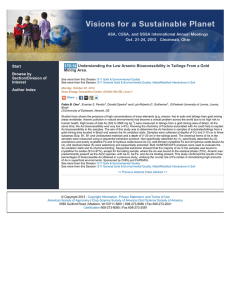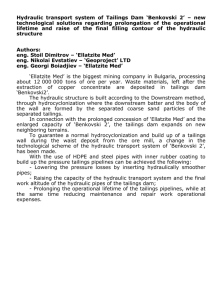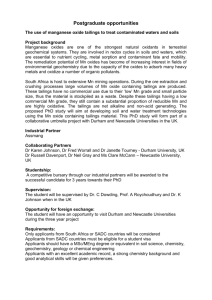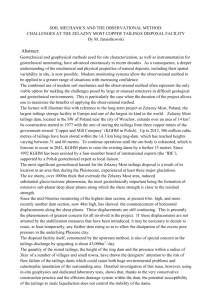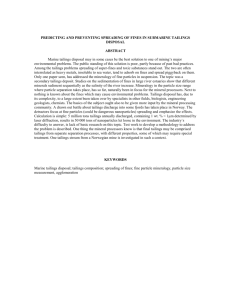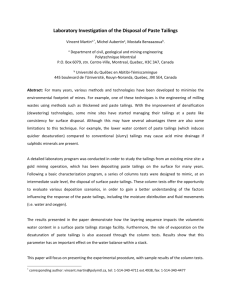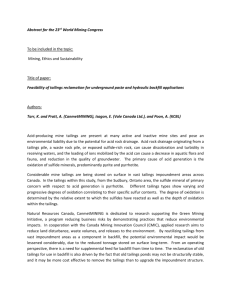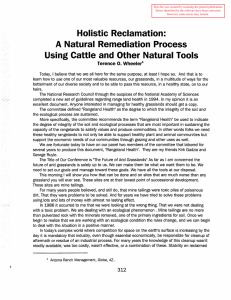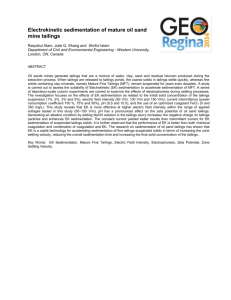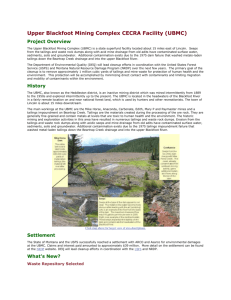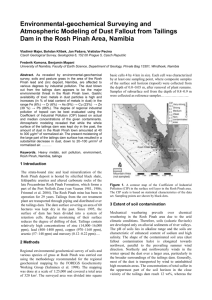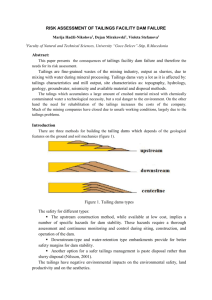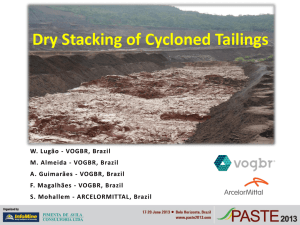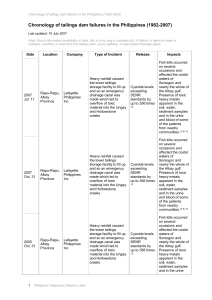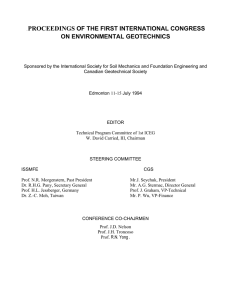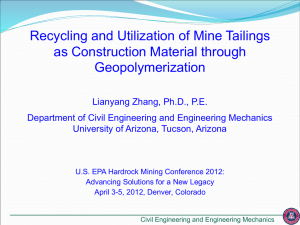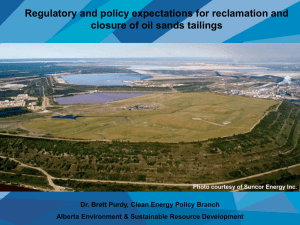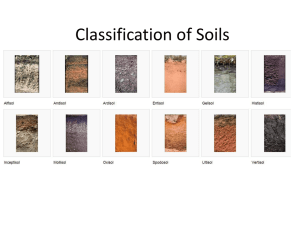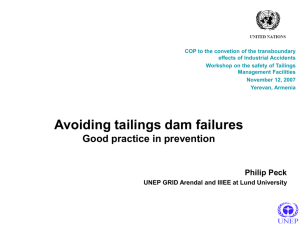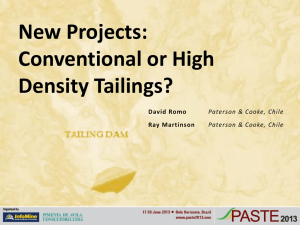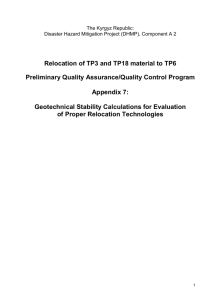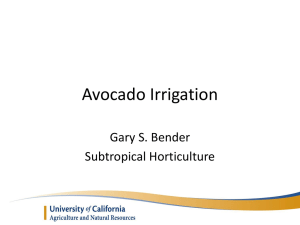Trace elements dispersion from a tailings dam and speciation in
advertisement
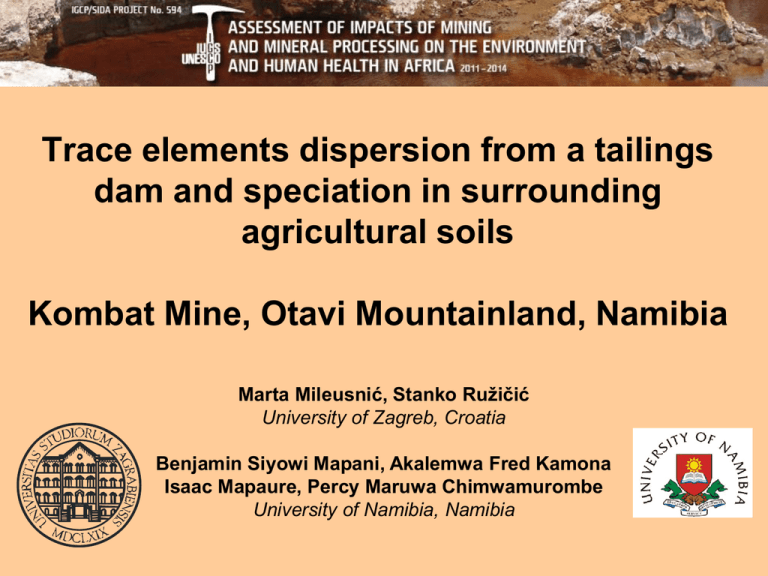
Trace elements dispersion from a tailings dam and speciation in surrounding agricultural soils Kombat Mine, Otavi Mountainland, Namibia Marta Mileusnić, Stanko Ružičić University of Zagreb, Croatia Benjamin Siyowi Mapani, Akalemwa Fred Kamona Isaac Mapaure, Percy Maruwa Chimwamurombe University of Namibia, Namibia STUDY AREA - Kombat Grootfontein district latitude 1943´S longitude 1743´E altitude of 1.590 metres 2 000 inhabitants Agriculture: (1) livestock production (2) maize, potatoes, vegetables and subtropical fruits Kombat Cu mine mining: 1962 – 2008 (46 years) 24,550,280 t of copper ore tailing dam (about 300 million T) Area: 20 ha Height: 3-4 m Sub tropical climate summer winter Summers -very hot -heavy downpours -northeastery winds Winters (May –June) -mild -dry winters - easterly winds Main agents of material transfer from tailings into surrounding areas WINTER - WIND SUMMER - RAIN WATER (as run-off in episodes of heavy downpours RESEARCH GOALS (1) to determine lateral distribution and seasonal variability of trace metals, as well as dominant metal binding mechanisms in the agricultural soil (2) to identify dominant type of metal dispersion from the tailings impoundment (mechanical or chemical) (3) to carry out preliminary assessment of environmental risk associated with tailings dam SAMPLING - after results of Kribek et al. (2006) 1) tailings 2) polluted soil 3) control soil -2 sampling campaigns: -Wet season – march -Dry season – august Analytical work (1) bulk mineralogy of soils and tailings (XRD) (2) Pseudototal metal content of soils and tailings (aqua regia digestion, AAS) (3) Binding sites of metals (sequential leaching, AAS) Fraction Exchangeable Label ADS/EXC Reagent Ammonium acetate Acid (carbonates) CARB Acetic acid Reducible FEMN Hydroxylamine hidrochloride Oxidisable OR/SUL Hydrogen peroxide Modified after: TESSIER et al. (1979) and SULKOWSKI et al. (2006) RESULTS Mineral content tailings: calcite and dolomite, quartz, micaceous material, +/-gypsum soil: quartz, calcite, dolomite, K-feldspar, plagioclase, clay minerals. pH tailings: circum-neutral (7.0-7.7) soil: alkaline (8.1-8.6) Pseudototal metal concentrations (median values in mg/kg) - no seasonal variation in concentrations Eleme nt Tailings Polluted farmland soil Control soils Cu 1328 112 18 Pb 946 117 17 Zn 107 49 27 Cr 16 20 27 Ni 3 9 12 Co 6 5 5 Cd 3 BDL BDL Canadian soil quality guidelines (CECME, 1999) for agricultural soils Metals binding forms in polluted soils 500 600 450 Cu 400 Pb 500 400 300 mg/kg mg/kg 350 250 300 200 200 150 100 100 50 0 0 ADS-EXC CARB FEMN soil fraction OR/SUL RES ADS-EXC CARB FEMN soil fraction OR/SULF RES CONCLUSIONS (1) Cu and Pb showed significantly high concentration in tailings. (2) Cu and Pb in all analysed samples of farmland soils west of the tailings dam exceed maximal allowed values for agricultural soils. (3) Seasonal variations - not observed. (4) The main binding site for Cu and Pb is oxide fraction (5) mechanical dispersion of elements from tailings dam prevails (6) carbonate minerals dominate in tailings - drainage is neutralized - lead and copper immobile (7) Pb and Cu relatively strongly bound to the soils + high pH of soil- small risk for their release in soil water and to groundwater (8) study by Casteel et al. (2006) - lead associated with iron oxide shows intermediate bioaccesibility while ingested (9) Rehabilitation of tailings dam necessary THANK YOU FOR YOUR ATTENTION
